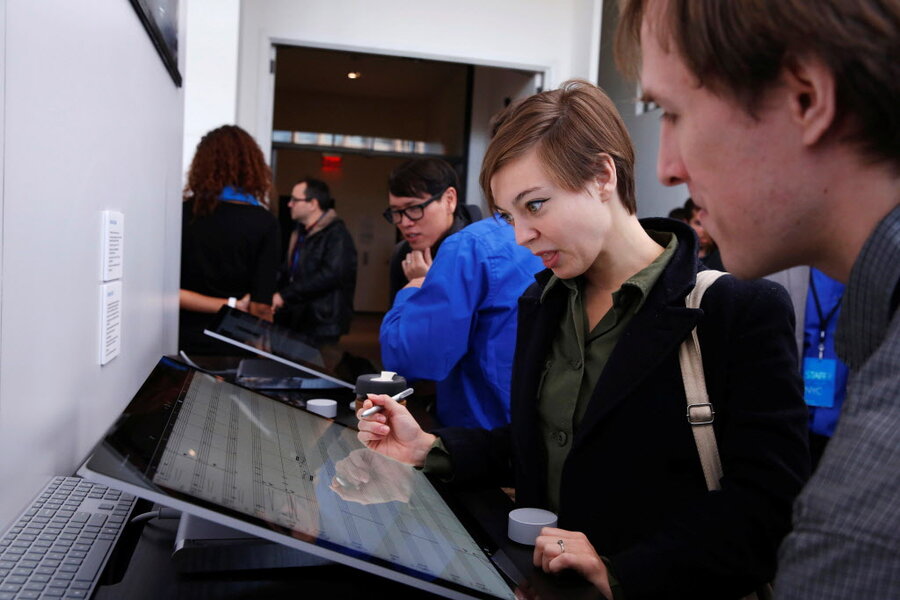Are creative professionals ditching Apple for Microsoft?
Loading...
Remember the old “I’m a Mac” ads? They were pretty much spot-on, if a bit reductive: PCs came with a cheaper price tag and a relatively open platform – fine for developers and casual users – but Apple computers offered sleek design and intuitive production tools. That’s why, for a long time, Macs were the computer-of-choice for creative professionals.
But if the MacBook Pro is any indication, Apple is shifting focus toward the average consumer. The company’s latest laptop does away with almost everything but the headphone jack – no more SD card slot, no more standard USB, no more HDMI. Non-upgradeable 16GB RAM and middling graphical capabilities have soured designers and filmmakers on the new device.
Meanwhile, Microsoft has taken bold steps to win over creators. The new Surface Studio comes with a 28-inch multitouch screen that folds on “zero gravity” hinges and is compatible with a host of design accessories. Users can easily switch between DCI-P3 and sRGB color models to see how their designs will look on other devices. But will the creative professionals, who were once so crucial to Apple’s business model, buy in?
“Historically, the creative professional market has been very important to Apple, and to the Mac platform specifically,” Hansen Hsu, curator of the Center for Software History at the Computer History Museum, tells The Christian Science Monitor in a phone interview. “When the original Macintosh came out in 1984, it actually had trouble gaining traction in market until Apple’s LaserWriter [printer] and Adobe’s post-production software came out.”
It was creative programs, such as PageMaker and Photoshop that got their start in the late 1980s and early '90s, that helped to jump-start the desktop publishing industry. This same industry would buoy Mac sales and save a faltering, Steve Jobs-less Apple from financial ruin.
“The creative professional market drove the high end of Mac hardware sales, which in the ’90s provided Apple with most of its profit,” Dr. Hsu says. “It was this market that kept Apple alive during its darkest years, from 1995 to 1997.”
But when Mr. Jobs returned, he began to shift Apple’s focus toward consumer products. The iPhone, which is now the company’s single greatest source of revenue, cemented that trend. Consequently, the Mac became a smaller part of Apple’s business model.
Some analysts say the company has abandoned creator-friendly design. It’s unclear whether this is true on the corporate level, but the perception is understandable – the Mac Pro desktop hasn't been updated in three years.
“Apple watchers look at this and think, ‘Well, clearly Apple isn’t focusing on that market anymore,’ ” Hsu says. “They feel like they have been forgotten because things like the Mac Pro have not been updated.”
In some ways, it’s the perfect time for Microsoft to swoop in. The company’s latest laptop isn’t just sleek, it’s daring – the Surface Dial accessory, for example, allows users to quick-change brush size and color setting with its tactile spinning wheel.
“The Surface Studio looks like the kind of device Apple has been known for: fresh and bold in its design, and geared toward creative professionals,” Seth Lewis, a professor of journalism and media innovation at the University of Oregon, tells the Monitor in an email.
Of course, Microsoft still has a formidable opponent in Wacom. The market leader in design tablets has multiple devices within the Surface Studio price range and is already widely used in creative industries.
And that may be why Apple is so willing to get out of Microsoft’s way.
“Most people don’t need to draw on their computers, and Apple is less and less about serving small niches of the market anyway,” Mr. Lewis says. “Instead, Apple appears to think that most people, most of the time, still need a keyboard-based, non-touch laptop interface to get work done in a portable way – and they’re probably right. The laptop as we know it today isn’t likely to change anytime soon.”








